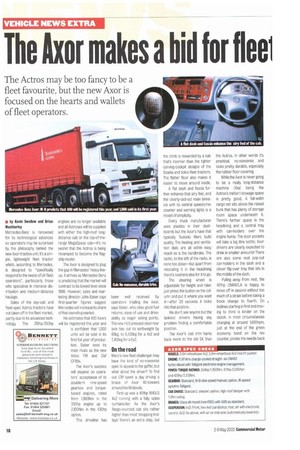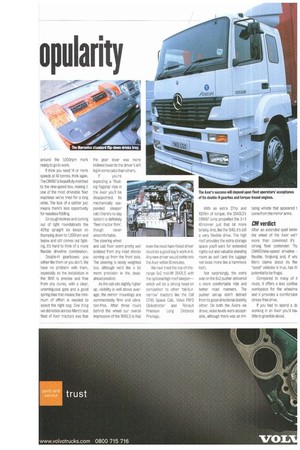The Axor makes a bid for fleei opularity
Page 16

Page 17

If you've noticed an error in this article please click here to report it so we can fix it.
The Actros may be too fancy to be a fleet favourite, but the new Axor is focused on the hearts and wallets of fleet operators.
by Kevin Swallow and Brian Weatherley Mercedes-Benz is renowned for its technological advances so operators may be surprised by the philosophy behind the new Axor tractive unit: it's a simple, lightweight fleet tractor which, according to Mercedes, is designed to "specifically respond to the needs of UK fleet operators", particularly those who specialise in Intensive distribution and medium-distance haulage.
Sales of the day-cab and fleet-spec Actros tractors have not taken off in the fleet market, partly due to its advanced technology. The 310hp/350hp engines are no longer available and all Actroses will be supplied with either the high-roof longdistance cab or the top-of-therange MegaSpace cab—it's no secret that the Actros is being revamped to become the flagship model.
The Axor is designed to plug the gap in Mercedes' heavy lineup. It arrives as Mercedes-Benz is predicting that the market will contract to its lowest level since 1998. However, sales and marketing director John Baker says first-quarter figures suggest Mercedes will increase its share of that dwindling market.
He estimates that 400 Axors will be registered this year and is confident that 1,000 units will be sold in its first full year of production. Baker sees its main rivals as the new Volvo FM and Dar CF85s.
The Axor's success will depend on operators' acceptance of its double-H nine-speed gearbox and torquebased engines, rated from 1,850Nm in the 350hp engine up to 2,100Nm in the 430hp option.
This driveline has been well received by operators trialling the Axor, says Baker, who cites good fuel returns, ease of use and driveability as major selling points. The new HL6 pressed-steel rear axle has cut its kerbweight by 80kg, to 6,435kg for a 4x2 and 7,405kg for a 6x2.
On the road
Merc's new fleet challenger may have the kind of no-nonsense spec to appeal to the gaffer, but what about the driver? To find out CM spent a day driving a brace of Axor 40-tonners around the Midlands.
First up was a 401hp 1840LS 4x2 running with a fully laden curtainsider. As the Axor's Atego-sourced cab sits rather higher than most 'shopping trolleys' there's an extra step, but the climb is rewarded by a cab that's roomier than the tighter curving-cockpit designs of the Scania and Volvo fleet tractors. The flatter floor also makes it easier to move around inside.
A flat dash and fascia further enhance that airy feel, and the clearly-laid-out main binnacle with its central speedo/rev counter and warning fights is a model of simplicity.
Every truck manufacturer uses plastics in their dashboards but the Axor's have that typically Teutonic Mere build quality. The heating and ventilation dials are all within easy reach as is the handbrake. The tacho, to the left of the radio, is none too close—but apart from relocating it in the headlining there's nowhere else for it to go.
The steering wheel is adjustable for height and rake: just press the button on the column and put it where you want it—after 20 seconds it locks into that position.
We don't see anyone but the lankiest drivers having any problem finding a comfortable position, The Axor's cab trim harks back more to the old SK than the Actros. In other words it's practical, no-nonsense and looks pretty durable, especially the rubber floor covering.
While the Axor is never going to be a really long-distance machine (that being the Actros's metier) stowage space is pretty good. A full-width cargo net sits above the raised bunk that has plenty of storage room space underneath it. There's further space in the headlining and a central tray with can-holders over the engine hump. The door pockets will take a big litre bottle; Axor drivers are clearly expected to drink in smaller amounts! There are also some neat pop-out can-holders in the dash and a clever flip-over tray that sits in the middle of the dash.
Pulling away from rest, the 401hp 0M457LA Is happy to move off in second without too much of a strain before taking a block change to fourth. On inclines starting in first and moving to third is kinder on the clutch. In most circumstances changing at around 1,600rpm, just at the end of the green economy band on the rev counter, plonks the needle back
around the 1,000rpm mark ready to go to work.
If think you need 14 or more speeds at 40 tonnes, think again. The 0M457 is beautifully matched to the nine-speed box, making it one of the most driveable fleet machines we've tried for a long while. The lack of a splitter just means there's less opportunity for needless fiddling.
On tough inclines and coming out of tight roundabouts the 401hp straight six keeps on thumping down to 1,000rpm and below and still comes out fighting. It's hard to think of a more flexible driveline combination.
Double-H gearboxes: you either like them or you don't, We have no problem with them especially as the installation in the 1840 is precise and free from any clunks, with a clear, unambiguous gate and a good spring bias that means the minimum of effort is needed to select the right cog. One thing we did notice across Merc's test fleet of Axor tractors was that the gear lever was more inclined towards the driver's left leg in some cabs than others.
If you're expecting a 'floating flagship' ride in the Axor you'll be disappointed, Its mechanically suspended sleeper cab (there's no day option) is definitely 'fieet-tractor firm', though never uncomfortable.
The steering wheel and cab floor seem pretty well isolated from any road shocks coming up from the front axle. The steering is nicely weighted too, although we'd like a bit more precision in the deadahead position.
As the cab sits slightly higher up, visibility is well above average; the mirror mountings are commendably firm and vibration-free. After three hours behind the wheel our overall impression of the 1840LS is that even the most ham-fisted driver could do a good day's work in it. Any new driver would settle into the Axor within 10 minutes.
We next tried the top-of-therange 6x2 mid-lift 2543LS with the optional high-roof sleeper— which will be a strong head-on competitor to other 'tall-butnarrow' tractors like the Oaf CF85 Space Cab, Volvo FM12 Globetrotter and Renault Premium Long Distance Privilege, With an extra 27hp and 100Nm of torque, the 2543LS's 0M457 lump propelled the 3+3 40-tonner just that bit more briskly. And, like the 1840, it's still a very flexible drive. The high roof provides the extra storage space you'll want for extended nights out and valuable standing room as well (and the luggage net looks more like a hammock too!).
Not surprisingly the extra axle on the 6x2 pusher delivered a more comfortable ride and better road manners. The pusher set-up didn't detract from its good directional stability either. On both the Axors we drove, noise levels were acceptable, although there was an irri
tating whistle that appeared t come from the mirror arms.
Chi verdict
After an extended spell behin the wheel of the Axor we'r more than convinced it's strong fleet contender. ThE GM457/nine-speed dnveline I flexible, forgiving and, if whE Merc claims about its fleE "seed" vehicles is true, has th potential to be frugal.
Compared to many of il rivals, it offers a less confine workspace for the wheelma and it provides a comfortabli stress-free drive.
If you had to spend a de working in an Axor you'd hay little to grumble about.
































































































































































